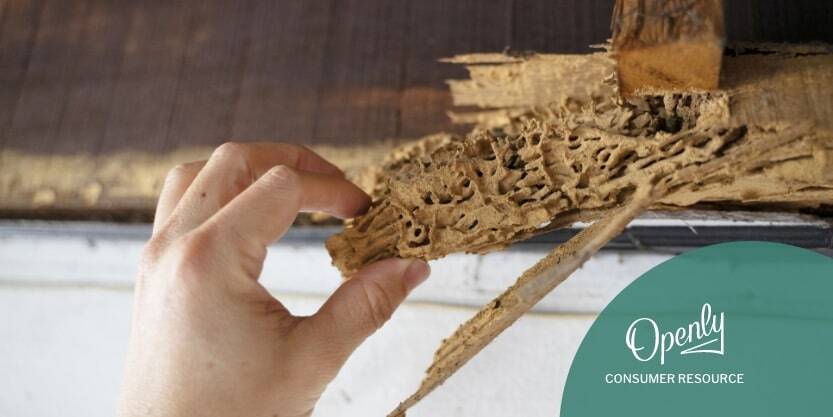Owning a home is a dream for many, but it can quickly turn into a nightmare if neglected.
Many homeowners underestimate the threat of a silent destroyer that can wreak immense havoc when ignored—termites. These insects are more than a pest, they are destructive insects that can cause significant structural damage that can cost thousands of dollars to repair.
But what happens if disaster strikes? Will your homeowners insurance cover termite damage? The unfortunate truth is, in most cases, the answer is no. However, that doesn’t mean you’re out of luck.
This article will explore the reasons why termite damage isn't typically covered by a standard homeowners insurance policy and empower you to take action, implement preventative measures, and address the issue before your dream becomes a nightmare.
At a glance:
- Homeowners insurance policies typically don’t have termite damage coverage because termite infestations are considered preventable through regular inspections and maintenance.
- Termites are silent destroyers that can cause significant structural damage to your home, leading to safety hazards and decreased property value.
- Regular termite inspections and preventative measures are key to avoiding expensive repairs.
Clarifying home insurance coverage for termites
Homeowners insurance is a financial safety net against the burden of repairs caused by unexpected events that can cause property damage and put personal belongings at risk. Although coverage varies by policy and type and insurance provider, homeowners insurance covers a range of perils including, but not limited to, fire, theft, and weather-related incidents. Home insurance helps you get back on your feet after such sudden or accidental disasters.
However, there are tiny critters that homeowners insurance doesn’t cover: termites.
Damage caused by insects and/or infestations is generally excluded from standard homeowners insurance policies because it is considered preventable. Unlike a sudden burst pipe or a fallen tree, termite problems develop over time. Regular home inspections and proper home maintenance can significantly reduce the risk of termites taking hold of and destroying your home.
In layman's terms, homeowners insurance is designed for the unexpected, not gradual deterioration caused by lack of regular inspections and home maintenance. So while termites may not be covered, taking steps to prevent them from becoming a destructive nuisance can save homeowners costs in the long run.
Understanding termite behavior and homeowner risks
Termites are social insects that feed on cellulose, the primary component of wood.1 The most common type of termites in the United States are subterranean termites. These termites live underground and build mud tubes from their nests directly to your home. As these pests burrow through the foundation and structural beams of homes, they can cause significant and extensive damage that may go unnoticed for years.
The risks associated with termite infestations aren’t small. Termites can cause extensive structural damage and can compromise the integrity of your home, potentially leading to safety hazards. From spongy floorboards to weakened support beams, an ignored termite problem can prove extreme. In addition, a severe termite infestation can significantly decrease your property value, making it difficult to sell your home in the future.
Signs of termite infestation
Spotting the signs of a termite infestation early can save homeowners a lot of hassle—and money!—down the road. Here are some common signs to watch out for:2
- Visible termite activity—The most obvious sign of a termite infestation is if you see live termites crawling around your home, you have an active infestation. Other visible signs can include frass, or dry wood termite droppings.
- Mud tubes—These tubes are built by subterranean termites to travel between their underground nests and your home's wooden structures. Look for pencil-sized tubes snaking up foundation walls or around crawl spaces.
- Discarded wings—If you notice piles of tiny wings near windows, doors, or anywhere else on your property, you may have a termite infestation. Swarmer termites, the reproductive members of a termite colony, shed their wings after a mating flight. Their presence means a new colony might be setting up shop in your home.
- Hollow-sounding wood—Conduct a tap test on wooden beams, floorboards, and furniture. If tapping on wood produces a hollow sound, it could indicate a potential termite infestation within.
- Damaged wood—If you have wood flooring that is buckling or has blisters, this may be a sign of a termite infestation. Termites start with the subfloor or support beams, so if you notice these signs of damage, the infestation could be severe.
- Doors and windows that stick—Are you suddenly struggling to open or close doors and windows? Termite damage can cause warping, making it difficult to open and close doors and windows.
Early detection is key to safeguarding the structural integrity of your home. If you notice any of the signs outlined above, do not hesitate to contact a pest control professional to address the infestation immediately. 
Termite prevention tips for homeowners
Taking measures to prevent and mitigate a termite infestation is the best way to reduce the financial burden and structural impact of termite damage.
Fortunately, there’s a two-pronged approach to keep these pests at bay: DIY risk mitigation and professional treatment. By combining preventative measures with professional expertise, homeowners can implement a formidable defense against termites, ensuring their home remains safe and sound.
DIY defense
When it comes to termites, offense may be the best defense. Follow these three steps to take a proactive approach to termite damage in your home:3
- Eliminate moisture sources—Termites love damp environments, which is why they are so prevalent in southeastern states. Regularly inspect your foundation for leaks, especially around pipes and crawl spaces, and ensure proper drainage around your home by keeping gutters clean and directing water away from the dwelling with downspouts that extend at least one foot away from the structure’s walls.
- Reduce wood contact—Keep wood away from your house and eliminate any wood-to-soil contact around your home’s foundation. This means removing old mulch piles, trimming overgrown bushes, and storing firewood at least 20 feet away from your home.
- Install physical barriers—Consider installing physical barriers like termite sleeves around pipes and wires entering your home. These create a tight seal that can deter termites from entering your home at these vulnerable spots. Additionally, placing bait stations strategically around your property can act as termite traps, attracting and eliminating termites before they can reach your home’s main structure.
Professional termite treatments
While DIY methods offer a proactive approach, sometimes it isn’t enough. Professional termite control is often necessary, especially when dealing with an established infestation. A qualified pest control company can offer a dual-layered approach to addressing a termite infestation:
- Thorough inspection—Professionals don’t just look for bugs, they look for signs of trouble. Professional pest control specialists use specifically designed tools and techniques to identify termite activity, assess the extent of the damage, and determine the best course of action.
- Targeted treatment—Depending on the severity of the infestation, different treatment options may be used. Treatment methods could include creating a chemical barrier around the foundation to prevent termites from entering the home, localized treatments for existing nests, or even fumigation for a complete eradication of pests.
Peace of mind through prevention
Regular inspections and preventative measures are key in the fight against termites. By being proactive, homeowners can minimize the risk of infestation and avoid the financial burden of expensive repairs. As the old adage goes: an ounce of prevention is worth a pound of cure, especially when it comes to protecting your valuable property.
But even the most diligent and responsible homeowner can’t eliminate every risk associated with owning a home. That’s where having the right home insurance comes in. Purchasing home insurance that is comprehensive will help mitigate the financial burden of owning a home, even if termite damage isn’t covered. Contact Openly for a personalized home insurance quote and discuss high-value home insurance coverage options that provide peace of mind.
* We provide this information to help you understand insurance. Any coverage is subject to the terms of your policy. Please refer to your policy and declarations page for complete terms, conditions and coverage details. Reference in this article to any specific commercial products, processes, or services, or the use of any trade, firm, or corporation name is for the information and convenience of the public and does not constitute an endorsement, recommendation, or favoring by Openly.
1 Terminix. “Termite Signs to Look for in Your Home.” Terminix.com. Accessed 28 May 2024. https://www.terminix.com/termites/signs/
2 Ibid.
3 United States Environmental Protection Agency. “Termites: How to Identify and Control Them.” EPA.gov. Accessed 28 May 2024. https://www.epa.gov/safepestcontrol/termites-how-identify-and-control-them#:~:text=Reduce%20openings%20that%20offer%20termites,free%20from%20blockage%2C%20including%20plants.




